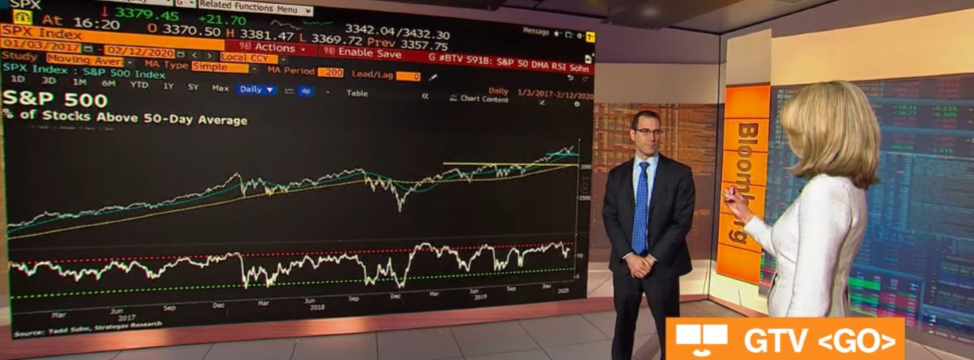
|

|

|

|

The Market and Management Seem to be at Odds on Earnings Projections
As of February 12, 70% of S&P 500 companies had reported earnings results for the fourth quarter and 2019 year. While the reporting season is still young, the initial reports are somewhat disappointing.
- Fewer companies are beating estimates. 72.2% of the companies reporting beat expectations. This may seem like a high percentage, but it is below the 12-quarter average of 77.9%. It is not unusual for most companies to report results above expectations as company management and analysts take a conservative view when making projections.
- Earnings growth is low. Net income for the fourth quarter rose 0.9% y-o-y on average for the companies that have reported. This is significantly below the trailing 12-month average of 11.8% but above recent quarterly growth numbers that have been negative. John Butters of Factset reports that if earnings growth in 2019-4Q ends up in the negative, it would be the first time the index has reported four straight quarters of y-o-y declines since 2016. Earnings per share growth has been slightly better due to share buybacks, but the overall growth remains anemic.
- Market is not rewarding favorable earnings. According to Factset, companies reporting positive surprises have seen an average price increase of 0.5% in the four-day window before and after the report date. This compares to a 1.0% increase for companies reporting earnings below expectations.
- Earnings estimates are being revised
downward. 2020-1Q estimates have been lowered to reflect the impact of the Coronavirus. The latest estimate is for 2020-1Q earnings to grow 1.2% year over year. This is down from a growth rate of 4.5% as recently as December 4, 2019, shortly before the outbreak of the Coronavirus. Even with the revision, such projections look rosy compared to negative growth in recent quarters and in light of the effects of the virus.
- The technology sectors have been strong while
manufacturing has been weak. The technology sector reported earnings that have been 9.4% above expectations while the manufacturing sector has reported results 3.7% below expectations. The technology sector has been buoyed by favorable results at Intel and Microsoft while the manufacturing sector can point to a large loss at Boeing to explain the negative surprise. Other sectors reporting favorable results include communications and consumer discretionary while results for the energy, utility and real estate sectors have been disappointing.
- Valuation multiples are high. The S&P 500 is trading at 18.4 times forward earnings versus a 10-year average of 15.0 times. The S&P 500 trades at 25 times trailing 12-month earnings versus an average P/E of 19.4 times since 1971. High valuation multiples are partly due to historically low interest rates. However, the fact that stock prices have risen at a faster rate than earnings estimates in recent quarters despite steady interest rates is a possible concern for investors.
The market believes there will be a rebound in earnings in 2020 even as management and analysts revise projections downward. Whether or not current projections are realistic or Pollyannaish remains to be seen. History would indicate that analysts begin the year with lofty projections and then lower them as management gives conservative guidance for the year. Actual results then surpass lowered expectations. So far, the current earnings period is showing a similar trend, perhaps amplified by virus concerns. This time, however, the market seems to be disregarding earnings results and dampened projections as it soars to new levels. As valuation multiples climb, it is getting harder and harder to make the case that the market is undervalued.
Sources
https://finance.yahoo.com/news/positive-earnings-picture-212009000.html, Sheraz Mian, Zacks, February 12, 2020
https://www.marketwatch.com/story/earnings-recession-set-to-end-as-sp-500-earnings-growth-turns-positive-2020-02-05, Tomi Kilgore, MarketWatch, February 5, 2020
https://www.forbes.com/sites/sergeiklebnikov/2020/01/07/earnings-preview-wall-street-banking-on-profits-to-rebound-in-2020/#4c8417865a3a, Sergei Klebnikov, Forbes, January 7, 2020
https://www.longtermtrends.net/price-earnings-ratio/, Longtermtrends, February 13, 2020
https://www.valuescopeinc.com/resources/white-papers/the-sp-500-pe-ratio-a-historical-perspective/,
ValueScope, February 13, 2020
https://www.yardeni.com/pub/peacocksp500revisions.pdf, Yardeni Research, January 27, 2020
https://www.factset.com/hubfs/Resources%20Section/Research%20Desk/Earnings%20Insight/EarningsInsight_013120.pdf, John Butters, Factset, January 31, 2020








